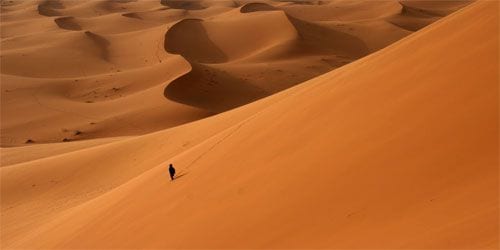
Maybe this sort of thing is just not supposed to be interesting unless somebody’s life is at stake. Otherwise, it’s hard to explain why Cecil Kuhne’s riveting new anthology of travel writing, Near Death in the Desert: True Stories of Disaster and Survival, is pitched so directly (at least in terms of title) at the extreme-travel crowd. In fact, this latest entry in Kuhne’s Near Death series — earlier installments were themed around the Arctic, Mountains, and High Seas — doesn’t really have that much to do with disaster, survival, or even courting death, really. What this skillfully curated collection does instead is present a multitude of takes on an even more basic (and frequently more fascinating) struggle: the yawning abyss of cultures.
In terms of unified theme, there are a few outliers here, with pieces set in India’s rocky Thar region, a suicidal rafting dash down the Grand Canyon, and another in the Mad Max-like chaos of the Nigerian bush taxi system. While all are excellently crafted, they don’t all quite fall under the book’s organizing principle of danger travel in the desert (unless the Nigerian bush is a more arid place than Peter Chilson’s adrenaline-charged essay describes).
The balance of Near Death in the Desert is taken up by first-person accounts of Westerners (ranging from the mid-19th century to the present day) riding truculent camels across vast stretches of arid wasteland in the company of locals who they regard with a mixture of awe and irritation. The immediate sense of dislocation is near universal here, and is by far the most fascinating thing about Kuhne’s collection. Whether traveling with Saharan tribesmen or Bedouins, the narrators undergo wrenching culture shock on nearly every page as they try and comprehend the ascetic and primal nature of the burning landscapes they are traversing.
Michael Asher’s piece about riding on camelback with his new wife from Morocco to Sudan starts out with this bit of cross-cultural jealousy at the arrival of his guide:
Mafoudh turned up at first light, bringing with him nothing but a blanket, a camel stick, and a much patched knapsack containing a teapot, a glass and a spare gandourah [a sleeveless garment]. I envied him his simple gear. Ours seemed to cover every bit of ground outside the house.
The camels heaped high with Asher and his wife’s equipment, Mafoudh then grabs the headrope of the leading camel: “‘In the name of God,’ he said, ‘the way is long. Let’s go!'” (There are few more thrilling ways to begin a story than the sight of a band of explorers hurling themselves into the vast wilderness.) By the end of the first stage of their grueling journey, Asher finally begins to understand exactly how long the way is — a simple realization that his prose is nevertheless able to transmit with sharp insight. And while one never quite feels that he, or most of the other writers in the book, were ever in that much mortal danger, the struggle and privation they endure are nonetheless impressive.
Although the book is replete with examples of excellent travel writing in the classic mold, where every detail of the landscapes passing by are described with crystalline clarity, the narrators ultimately become much more fascinated by the people they are traveling with. Though this inevitably translates in many instances as the frustration of schedule-oriented Westerners butting into the Arab nomad’s clockless and abstract attitude toward time, it usually mutates into the writers’ appreciation for the ways in which the people they are traveling have adapted to their seemingly unlivable environment.
Wilford Thesiger’s “The Last Nomad”, a gripping piece about adventuring on the Arabian Peninsula in the years immediately after World War II (weirdly enough in the employ of an agency with the comedic-Orwellian name of The Desert Locust Control), is one of the best pieces in this vein. Although Thesiger, who lives up to his billing as a latter-day T.E. Lawrence, has a good eye for the land, he spares no expense in talking about the tribesmen who rode with him across the burning sands of the dreaded Empty Quarter. Like Lawrence, the “desert-loving English”, Thesiger regards the peninsula’s harsh vastness with something like love: “In deserts, however arid, I have never felt homesick for green fields and woods in spring, but now that I was back in England, I longed with an ache that was almost physical to be back in Arabia.”
Thesiger came to the Peninsula just in time to watch the last days of true Bedouin culture, and his writing nearly aches with love for what is about to disappear in the coming onslaught of oil-fueled modernity:
I shall always remember how often I was humbled by my illiterate companions, who possessed in so much greater measure generosity, courage, endurance, patience, good temper, and light-hearted gallantry. Among no other people have I felt the same sense of personal inferiority.
Amidst such revelatory insights (especially amazing coming from a scion of the British Empire), which come fast and thick in a book crowded with stunning passages — particularly from William Langewiesche and Geoffrey Moorehouse, both of whom achieve a painfully won understanding of the desert and those who dare to live in it — the possibility of death almost pales into insignificance.
